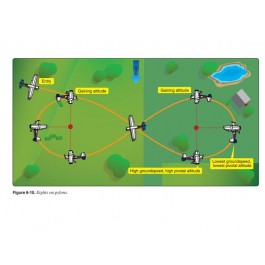|
|
Eights On PylonsDescriptionTeach applicant to use smoke, ground track, etc to determine where the wind is coming from. Do not reply on GPS or AWOS/ATIS for this. Smoke from smoke stacks is great to determine wind direction - see pictures here.Harry's YouTube video on this maneuver; FAA material pdf on Flymall server Over the years, the FAA has changed the illustrations for this maneuver. The newer illustrations are not exactly correct. See below. From the old Flight Training Handbook AC 61-21A On page 6-17 of the pdf below, it says "The pilot may make corrections for temporary variations, such as those caused by gusts or inattention by reducing the bank angle slightly to fly relatively straight to bring forward a lagging visual reference line or by increasing the bank angle temporarily to turn back a visual reference line that has moved ahead." Knowledge The applicant demonstrates understanding of: CA.V.E.K1 Purpose of eights on pylons. CA.V.E.K2 Aerodynamics associated with the eights on pylons to include coordinated and uncoordinated flight. CA.V.E.K3 Pivotal altitude and factors that affect it. CA.V.E.K4 Effect of wind on ground track. CA.V.E.K5 Phases of the eights on pylons maneuver from entry to recovery. Risk Management The applicant demonstrates the ability to identify, assess and mitigate risks, encompassing: CA.V.E.R1 Failure to divide attention between airplane control and orientation. CA.V.E.R2 Collision hazards, to include aircraft, terrain, obstacles, and wires. CA.V.E.R3 Low altitude maneuvering including, stall, spin, or CFIT. CA.V.E.R4 Distractions, loss of situational awareness, or improper task management. CA.V.E.R5 Failure to maintain coordinated flight. CA.V.E.R6 Failure to manage energy state. CA.V.E.R7 Emergency landing considerations. Skills The applicant demonstrates the ability to: CA.V.E.S1 Clear the area. CA.V.E.S2 Determine the approximate pivotal altitude. CA.V.E.S3 Select suitable pylons that will permit straight-and-level flight between the pylons. CA.V.E.S4 Enter the maneuver in the correct direction and position using an appropriate altitude and airspeed. CA.V.E.S5 Establish the correct bank angle for the conditions, not to exceed 40°. CA.V.E.S6 Apply smooth and continuous corrections so that the line-of-sight reference line remains on the pylon. CA.V.E.S7 Divide attention between accurate, coordinated airplane control and outside visual references. CA.V.E.S8 Maintain pylon position using appropriate pivotal altitude, avoiding slips and skids. ComLP, CFILP Detailed Information
|












